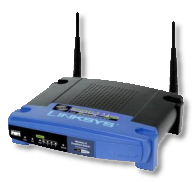I recently helped a friend of a friend with a wireless networking setup who has a Seriously Large House–we’re talking easily 10,000 sq. ft. per floor, and the house has 3 floors. Yeah, it’s that big. They had set up a Linksys WRT54G and two WRE54G repeaters and, no surprise, had horrible signal coverage and frequent packet loss, and this was just trying to provide connectivity to a single floor in the house. Needless to say, they were not pleased, so I was invited to take a look and fix things.
I’ve always heard good things about the third-party firmware DD-WRT, so I decided to give it a shot. I picked up two WRT54GS routers ($70 at Amazon.com) and installed DD-WRT on them. I also installed DD-WRT on the WRT54G they already had.
Oh, a word of advice–if you recall, I bought one of those WRE54G’s back in May 2007–don’t waste your money on them. They cost more than the WRT54GS, can’t run DD-WRT as far as I know, and they only have one antenna, which means losing half your bandwidth per repeater hop. There’s absolutely no reason to use them, whatsoever–unless you’re not willing to figure out DD-WRT, of course.

So, I configured one WRT54GS as the master which has the WAN uplink providing network access to the wi-fi cloud. The remaining WRT54GS and WRT54G were configured as repeater bridges, all with the same SSID to facilitate roaming which worked perfectly–only one (!) packet dropped when roaming between AP’s. I did crank the power up from the default 28mW to 60mW which made a significant difference in signal range and coverage.
With this, there’s reasonable coverage on the first floor, but most importantly full coverage on the second floor which is where they were most interested in. The third floor gets good signal strengh in spots, but that’s adequate for now.
Overall, for the price, the Linksys WRT54GS is a fantastic product and when used with DD-WRT, can be used qutie effectively.
A good bit of information for me would be (I found this while doing a google search on how to enable the mythical “roaming” feature mentioned in WRT54G manuals) exactly what settings you used to get the devices to talk to each other. Are the routers all connected by ethernet and simply act as a seamless WiFi blanket or do they repeat signal from each other? My goal is to have a completely wireless repeater device. I have WRT54G with DD-WRT on it as my main router and I have several other devices (WRT54G, Edimax EW-7416APn V2, etc) that I would like to use as WiFi repeaters.
I haven’t written up a simple walk-through installation guide, but I documented some more details here:
http://dossy.org/2008/02/configuring-ddwrt-as-a-wirelesswired-router-and-bridge/
For my home setup, all routers are connected via ethernet and provide a continuous Wi-Fi blanket, with each router on a different channel.
I do, however, have a “portable” WRT54G running DD-WRT that I have configured as a wireless repeater, which I take with us when vacationing. I configure it to connect to the Wi-Fi wherever we’re staying, and then act as an AP for the Wi-Fi devices we bring with us. I bump up the TX/RX power to get better range, so it can reach the upstream Wi-Fi, as necessary.